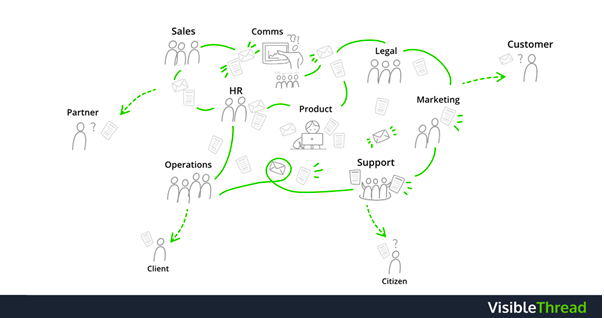It’s true. Our attention spans are diminishing.
This is largely the result of too much content in our lives. And too much distraction.
Our brains are incredible organs. (Don’t believe all the hype around goldfish and memories!) However, they simply can’t cope with the load.
The idea that our brains have limited working memory to process information is called cognitive load theory. An overload of unnecessary input causes our brains to seize up. Sound familiar?
How your organization adds to the cognitive load
You’ve probably heard “content is king” many times. Many marketing teams are aware of the impact content can make to an organization. High quality content can help teams meet customer and revenue goals.
But, it’s not only your marketing teams who are creating content for your customers.
Multiple teams across your organization are creating consumer-facing content. Think of product manuals, service terms, privacy documentation etc.
Thinking about your customer – and your content
Your customers are presented with the content produced by your entire organization. But we need to remember, there’s more going on with your customer than you think there is.
Your content might be highly personalized. You may have done your persona research. You know your customers’ education levels, age, job title, motivations etc.
But this still doesn’t tell you exactly how to write for your busy customer.
Why?
Because your customer is not “just” reading content.
The overt activity is:
- Reading a blog
- Understanding a white paper
- Following a purchasing path on a website
- Finding urgent contact information.
But what else is happening?
- People are scanning for relevant information
- They’re finding their way around your content layout
- Readers are breaking down complex language to understand better
- They’re grasping new concepts
And, most of all, people are doing real-life stuff.
- Standing in a line waiting for coffee
- Looking after children at a playground
- Waiting for a bus
- Etc.
In other words, your customer has a lot going on.
Don’t add to your customer’s load with complex content and a heavy cognitive tax.
If your content is not clear and easy to consume, your customer will experience an overload. And they’ll need to switch something off to reduce that load.
That could be your content.
The cost to your business
The content tax bill will ultimately be forwarded to your business.
Readers switching off to your content often results in a high bounce rate. Some of your web-pages could have as much as a 70% bounce rate. The money you’re spending on content for your valued client is actually what’s driving them away. Maybe not the best investment then.
I’m not saying stop content marketing.
I’m saying be aware of who your customer really is. Don’t believe the fallacy of the sophisticated reader.
Optimize for readability
So what is it that can make your content king? The content itself is one aspect, but presenting it in a form that’s readable is key. This isn’t a soft concept.
Readability is measured objectively. And high readability scores create a low cognitive load.
Jakob Nielsen, world-renowned researcher and usability expert, found that people read 20% of a website. That was in 2008.
An internet minute in 2019 is so busy that you have 50 milliseconds to make a good impression. That’s 0.05 seconds.
Content that taxes customers with too high a cognitive load will see them switch off. People will immediately stop reading your printed content. Or bounce off of your web page.
The opposite is true for content that doesn’t tax customers with a high content load.
If you write content with a high readability score, you’ll earn the trust of your customers. They’ll engage much better with you and reward you with their loyalty.
Reading content written in plain language reduces the cognitive load of your customer. They don’t need to work hard to understand what you’re saying. They will feel loyal towards your brand. No customer appreciates words for the sake of words
Writing for readability
Remember that you yourself are a consumer of content. Write in plain language to give your customers what they want quickly.
- Focusing on user experience will make your writing simpler
- Present content clearly
- Use short sentences
Write for yourself.
- Pose questions you would like to see answered and answer those
- Break complex ideas into smaller pieces
- Use subheadings
- Minimize calls-to-actions
- Lose the jargon
Use technology for objective readability metrics
The Flesch-Kincaid readability test is an algorithm to measure the cognitive level of copy. It was developed by the US Navy in 1975 to assess training manuals.
Your content serves you, but first and foremost, it should serve your customers. Don’t force them to pay a content tax to consume your words. Creating content with high readability will do them a favour and ultimately benefit your business.
